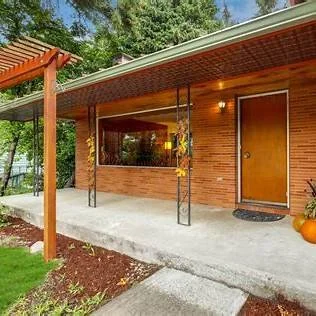GLENDOVEER
A hidden NE Portland neighborhood with some midcentury gems
The Glendoveer neighborhood in East Portland, Oregon, boasts a rich history and a distinctive array of housing styles that reflect its mid-20th-century development.
Historical Overview
Glendoveer's origins are closely tied to establishing the Glendoveer Golf Course. Built in 1923 by Frank Stenzel, the course was initially envisioned as the centerpiece of a residential development. However, its popularity led to the addition of a second course, making it Oregon's only 36-hole public golf facility at the time. The area was highly desirable and was even considered in the 1930s as a potential site for the Portland International Airport, as Glendoveer was considered to be “virtually fog free.”
The golf course remained under the Stenzel family's ownership until 1968, when it was sold to Portland Sanitarium and Hospital. After a series of ownership changes and development proposals, Multnomah County acquired the property in 1974, and it was later transferred to Metro in 1993.
The residential development of the surrounding area began in earnest in the late 1940s. In 1949, Paul and Stina Stenzel platted the neighborhood adjacent to the golf course, capitalizing on the area's appeal as a serene, wooded setting with large lots and mature fir trees.
Housing Types and Architectural Styles
Glendoveer is renowned for its collection of mid-century modern ranch-style homes, predominantly constructed between 1950 and 1960. These single-story residences are characterized by their open floor plans, large windows, and integration with the natural landscape. The neighborhood's design emphasizes spaciousness, with wide streets and generous lot sizes. Early zoning regulations enforced minimum lot widths of 70 feet and setbacks of 30 feet in the front, 25 feet in the rear, and 10 feet on the sides, fostering a low-density, suburban environment. (Restore Oregon)
Architects A. Quincy Jones and Frederick E. Emmons, known for their work on California's iconic Eichler homes, contributed to Glendoveer's development in 1957. Their influence is evident in the neighborhood's emphasis on modernist design principles and harmonious integration with the surrounding landscape. (Reed Neighborhood Association)
Contemporary Developments
While Glendoveer maintains its mid-century charm, the neighborhood has also seen the introduction of modern apartment complexes that complement its historical character. For instance, Glendoveer Woods Apartments offers contemporary living spaces with high-end finishes and energy-efficient appliances, situated on three quiet acres that provide peaceful views of gardens and the surrounding community.
Additionally, Glendoveer Golf View Apartments provides residents with quality two-bedroom, two-bath units, featuring amenities such as off-street parking and garages .(Apartment Guide)
Community and Lifestyle
Glendoveer's appeal lies in its tranquil, suburban atmosphere within close proximity to Portland's urban amenities. The neighborhood's mature trees, spacious lots, and access to recreational facilities like the Glendoveer Golf Course and its surrounding fitness trail contribute to a high quality of life for residents (Apartmentguide.com)
Glendoveer has a limited housing stock and many homes on large lots than those typically seen in Portland. For those who don’t mind the 20-30 commute to the city center, the suburban feel of the winding streets and the mature trees provide a peaceful community with parks and shopping nearby.
Further Exploration
For those interested in exploring Glendoveer's housing history and architectural styles in more depth, consider the following resources:
Restore Oregon's overview of East Portland's mid-century neighborhoods
Oregon Historical Society's guide to researching house and building history
These resources provide valuable insights into the neighborhood's development and the broader context of Portland's architectural evolution.
Share & follow




